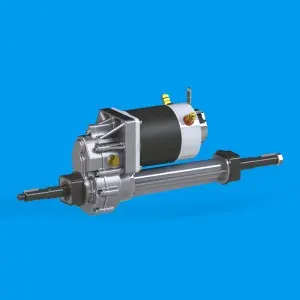A vehicle’s drivetrain is undoubtedly a complex project, but within this complex system lies an important component known as the transaxle. In this blog post, we’ll delve into the inner workings of a transaxle, clarifying what it does, its components, and how it contributes to the overall functionality of a vehicle.
Learn about transaxles
A transaxle combines two important automotive components: the transmission and the axle assembly. Unlike conventional drivetrains, which separate the transmission and axle components, a transaxle combines these elements into a single unit. This integration improves vehicle efficiency, performance and handling while reducing weight and complexity.
Components of the transaxle
1. Transmission: At the heart of the transmission is the variator, responsible for transmitting power from the engine to the drive wheels while allowing the driver to change gears. The gearbox consists of multiple gears, a clutch mechanism and synchronizers to help with smooth gear changes.
2. Differential: The differential causes the wheels on the same axle to rotate at different speeds. It consists of a ring gear, pinion and side gears, ensuring that power is evenly distributed between the wheels when cornering and preventing tire slippage.
3. Halfshaft: The halfshaft connects the transaxle assembly to the drive wheels and transmits the power generated by the transmission and differential to the wheels. These axles are designed to handle huge amounts of torque and contribute to the overall strength and stability of the vehicle.
4. Final drive: The final drive consists of a set of gears that determine the overall reduction ratio between the transmission output shaft and the drive wheels. This ratio affects the vehicle’s acceleration, top speed and fuel efficiency.
How does a transaxle work?
When the driver initiates vehicle motion by engaging the clutch and selecting a gear, power is transmitted from the engine to the transaxle. The gears within the transmission then mesh to create the desired gear ratio, effectively transferring torque to the differential.
When the vehicle is moving, the differential ensures that power is transmitted to the two wheels while allowing them to spin at different speeds when cornering. This function is made possible by ring gears and pinions within the differential, which distribute torque evenly between the wheels according to the turning radius.
At the same time, the half shaft transmits the power generated by the transaxle to the drive wheels, which rotates the drive wheels and propels the vehicle forward or backward. By combining the transmission and axle assembly, transaxles enable smoother power transfer, improved handling and efficient engine performance.
in conclusion
From the synchronization of gears in a transmission to the even distribution of torque through a differential, a transaxle plays a vital role in a vehicle’s drivetrain. These integrations contribute to smoother gear changes, enhanced handling and improved fuel efficiency.
Next time you’re taking a road trip in your car, take a moment to appreciate the inner workings of the transaxle. This ingenious marvel of engineering harnesses the engine’s power effortlessly, optimizes torque distribution, and delivers a seamless driving experience.
Post time: Jun-21-2023


